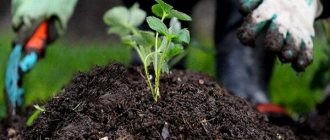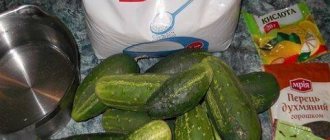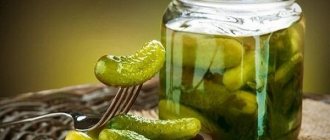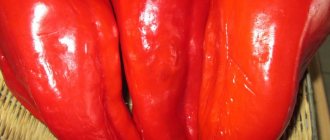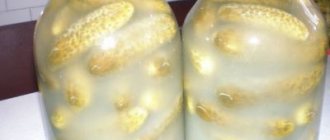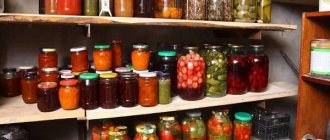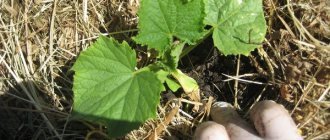The middle of summer is behind us and it’s time to think about creating the first preparations for the winter. One of the main ingredients in every recipe is salt. In this regard, many summer residents ask a reasonable question: what salt is best to use?
Read on dacha6.ru:
Adjika from zucchini for the winter with tomato paste
Recipe for pickled diced beets for the winter
cucumbers
Salad cucumber and pickling cucumber are completely different. It is a mistake to think that any cucumbers are suitable for pickling; on the contrary, the better quality they are, the better they will crunch in a jar. For salad they are needed completely differently than for canning.
The cucumbers should be small, in which case they will fit well in the jar.
Small young cucumbers have the best, sweetest taste. There are usually no voids inside them, so these cucumbers will crunch.
The skin should not be smooth. Pimples and black spikes are required.
The cucumbers should be firm to the touch, not too dark, and the light part should not be yellowish.
The skin should be thick. Then the cucumbers will turn out crispy.
Article on the topic
With tomatoes and peppers. Recipes for eggplant preparations
Is it possible to cover cucumbers with fine extra salt?
If you roll cucumbers, it is better to use a coarse-grained product. If it is too fine, then dissolution will occur quickly and the fermentation time will be reduced. When using large crystals, dissolution will be slower and during this time the bacteria will cope with the pickling process and the housewife will receive tasty and crispy cucumbers.
Zucchini
When choosing zucchini, pay attention to the size. They should be medium in size, no more than 15-20 cm.
The zucchini peel should be thin and smooth to the touch.
The even color of zucchini - from yellowish-green to green-brown - is a criterion of good quality. The presence of dark yellow or brown spots on the vegetable indicates that the fruit inside is spoiled and should not be eaten.
Eggplant vs zucchini. What is healthier and when should you eat them? More details
Which salt to choose
Before you start pickling cabbage using one of the recipes below, you need to purchase good quality sea salt. In any store you can easily purchase spices of different grinds; it can be either perfectly white or gray. Before paying for a product, you must study its composition to make sure there are no unwanted impurities. Sea salt is very capricious, and therefore it must be stored correctly. It is better to use small glass jars with a lid as containers for valuable products.
It must be remembered that sea salt is not suitable for preservation if the brine is to be boiled. During heat treatment, the product completely loses its valuable properties.
Tomatoes
They should be small.
Tomatoes for canning should smell good and the stem should be easily separated from them: this indicates ripeness.
For tomato juice, you can also use cracked tomatoes (but no rot!), but for pickling and pickling - only elastic, undamaged fruits.
Article on the topic
Canned food without salt and sugar. About the little secrets of preparing for the winter
It is better not to take pink, yellow and other exotic tomatoes for canning. The simplest ones are red. Yes, and cheaper.
The best salt for pickling cucumbers
The middle of summer is behind us and it’s time to think about creating the first preparations for the winter. One of the main ingredients in every recipe is salt. In this regard, many summer residents ask a reasonable question: what salt is best to use?
Read on Dacha6.ru:
What are the options?
On sale today you can find, at a minimum, rock, iodized and sea salt. We list the main advantages and disadvantages of each product:
- If you want to get the classic tart taste of pickles, then seal the jars with traditional rock salt. This excellent natural preservative will prevent jars from exploding during storage and will prevent the cucumbers in them from becoming soft. This salt is cheaper than others.
- Recently, iodized salt has been gaining popularity. Indeed, in most regions of our country there is a problem of iodine deficiency. In some regions of central Russia, residents consume 5 times less iodine than necessary. And this affects a person’s IQ, the functioning of the thyroid gland, and leads to delays in physical development in children. In addition, iodine itself is an excellent disinfectant and kills foreign microorganisms well. But canned cucumbers and tomatoes with iodized salt, according to many summer residents, are stored noticeably worse. Plus, there is a slight smell of iodine and a characteristic mild bitterness. After some time, the fruits turn, as my grandmother says, into pulp.
- You can also use sea salt for preservation. It costs several times more than stone, and is often packaged in smaller packs (450 g, for example). Of course, there are many fakes, but if the salt is still sea salt, then it has a number of valuable advantages. After eating pickles, a person will not experience swelling caused by stagnation of fluid in the body due to a large amount of salt. In addition to this, sea salt contains several dozen beneficial minerals that are essential for human health. For preparations, you should choose coarsely ground sea salt.
By the way, it is important to note that recently a more stable substance, potassium iodate, has been used to iodize salt. It is not subject to destruction during heat treatment and long-term storage. Now manufacturers guarantee that such iodized salt can be stored for up to 9 months without losing its valuable qualities.
It's up to you to decide what salt to make the preparations with. For example, you can make a couple of jars with different types of salt so that in winter you can personally check the quality of each of them. If there is no difference (in taste, physical properties of the pickled fruits), then use iodized or sea salt in the future, as they are more beneficial for health.
Video about the benefits and harms of different salts
Salt and companions
For pickling, it is better to use coarse salt: the vegetables turn out crispy. But after preparing the brine, it must be strained through cheesecloth.
Never use aspirin when canning vegetables - it creates harmful compounds in the brine that negatively affect the liver and kidneys. To better preserve home-canned food, many people add vinegar to them.
It’s healthier to add natural apple cider vinegar or red currant or cranberry juice (200 ml of juice per liter of brine) - and the canned food also tastes milder. You can also use citric acid (half a teaspoon per liter of water).
It is advisable to add finely chopped leaves or pieces of horseradish root to pickles - the brine will remain transparent. And one more nuance: vegetables are placed in a jar with herbs, but peppercorns and bay leaves must be boiled in brine.
And one last thing. Tap water for preparing brines and marinades must be passed through a filter.
What influences the choice of salt for preservation?
When purchasing, choose between iodized, stone and sea. The choice of the right option for pickling cucumbers depends not only on the quality of the resulting product, but also on the composition.
It is a common belief that, although iodized salt is good for health, it is nevertheless not suitable for pickling vegetables.
Seafood and regular table salt are often used to make pickles, but the former contains a much more useful composition.
How to sterilize jars
Prompted by Alexey Zharikov, chef at Culinaryon culinary studio
To sterilize jars, the easiest way is to bake them in the oven. You need to take a clean baking sheet and place jars, lids and rubber bands on it. You can put everything wet. Place the baking sheet in the preheated oven on the lower rack with the large jars at the back if possible. If you are going to make jam, then the oven needs to be preheated to 90-95 degrees, but if you are making pickles, then to 100-110 degrees. Keep the jars in the oven for 25-30 minutes. The main thing is not to overdo it, otherwise they will burst.
Pickled hot pepper
Photo: Shutterstock.com
Ingredients:
Hot small pepper - 1 kg Water - 1 l Salt - 2.5 tbsp. l. Sugar - 2 tbsp. l. Vinegar - 50 ml Mustard seeds - 1 tbsp. l. Allspice - to taste Bay leaf - 3 pcs.
How to cook:
1. Wash the peppers and place them in sterilized jars.
2. Boil water and add spices and salt to it. Then add vinegar and bring to a boil again.
3. Pour the marinade over the peppers, roll up and let cool.
Stuffed eggplants
Photo: Shutterstock.com
Ingredients:
Eggplant - 1 kg Carrots - 100 g Garlic - 100 g Sweet pepper - 100 g Salt - 2.5 tbsp. l. Mint - to taste Parsley - to taste Grape vinegar 6% - 300 ml
For saline solution:
Salt - 100 g Water - 1 l
How to cook:
1. Wash the eggplants, cut off the stalks, cut lengthwise not completely (if desired, you can partially remove the pulp) and boil for 2-3 minutes in a saline solution.
2. Then remove the fruits, cool and squeeze out excess water, leaving them under pressure for 15-20 hours.
3. For minced meat, chop the peeled garlic with salt, add finely chopped or grated sweet peppers, carrots, parsley, mint, hot peppers and mix.
4. Stuff the eggplants with minced meat and wrap each with thread. Place them tightly in jars and fill them with grape vinegar.
5. After 4-5 days, the eggplants will be ready. They should be stored in a cool place or rolled up and transferred to sterilized jars. Before serving, remove the strings and slice the eggplants lengthwise.
Small or large?
Already when describing the types of salt, it was mentioned that it can be of different grinds. Particle size is really important for pickling and preservation. Coarse table salt is traditionally considered the best option for home preparation. Let's try to understand why this happens using specific examples.
- Cabbage . For pickling, choose table salt with large or medium crystals. Small grains quickly dissolve and disrupt the normal fermentation process. As a result, the cabbage turns out to be more sour than salty. And such a product is stored less. In turn, large granules dissolve more slowly, and this allows lactic acid to ferment moderately without peroxidizing. This cabbage will be crispy, piquant, and can be stored for a long time.
- Mushrooms . The texture of mushrooms is dense and meaty, and when canning you want to preserve these properties. However, the product behaves very capriciously in preparations. Therefore, it is better not to take risks and not use salt with additives. This can lead to an unpredictable effect - the appearance of bitterness and an unpleasant odor, the proliferation of acidic bacteria, loss of elasticity, etc.
- Fish . The biggest danger when salting fish is botulism. Coarse table salt also allows you to avoid the risk of poisoning. Its crystals penetrate the protein tissue gradually, evaporate excess moisture and create an unfavorable environment for the growth of bacteria. In addition, it is quite difficult to over-salt fish with coarsely ground spices: it will absorb as much seasoning as it needs to be tasty and safe.
- Greens (parsley, cilantro, basil, dill) . For tender greens, coarse table salt is also suitable. Just put chopped greens in jars, sprinkle with crystals, and they will stay fresh until spring.
- Cucumbers and tomatoes . These are very tender vegetables that contain a lot of water. In order not to disturb their water “balance”, salting should also proceed slowly. In this regard, coarse grinding is the best you can find for canning. The crystals moderately saturate the vegetables with salt, do not allow them to ferment and prevent the marinade from acidifying.
Cucumber salad
Photo: Shutterstock.com
Ingredients:
Large overripe cucumbers - 1 kg Mustard seeds - 50 g Onions - 1 pc. Garlic - 1 head
For the marinade:
Water - 500 ml Table vinegar 9% - 500 ml Salt - 1.5 tbsp. l. Sugar - 100 g
How to cook:
1. Peel and seed the cucumbers, cut into cubes and pour boiling water and vinegar over them. Leave for an hour.
2. Drain, add salt and sugar and cook the marinade.
3. Place the cucumbers in jars, sprinkling with mustard and chopped onions and garlic.
4. Strain the marinade, boil and pour over the cucumbers.
5. Pasteurize the jars at 90 degrees (half-liter jars for 10 minutes, large jars for 15 minutes) and roll up the cucumbers.
Let's sum it up...
So, so that the wrong choice of salt does not ruin your entire season, remember these rules.
- An ideal and time-tested option for preserving herbs, vegetables, mushrooms (as well as meat and fish) is coarse or medium-sized table salt.
- “Extra” salt (finely ground) is suitable for marinades. However, it is better to limit its use solely to improving the taste of everyday dishes. It is absolutely not suitable for fermentation. And when preparing the marinade, there is a risk of oversalting.
- Special salt for canning (medium grind) - ideal for those who are just mastering the art of homemade preparations.
- Any impurities and mineral additives in salt can cause changes in the taste, consistency and color of products. Therefore, it is better to carefully check the composition of the salt and opt for pure sodium chloride.
Salt is one of the main reasons why trouble can happen to products. However, do not forget that there are also varieties of vegetables that are unsuitable for preservation. In addition, the quality of seams depends on the water. It is recommended to use spring, well or filtered tap water.
Harvesting season is just around the corner. Now you know the reason why, using the same proven recipe, you often get unpredictable results. This means it’s up to you to decide whether to buy coarse or medium-ground table salt, traditional for pickles, or continue experimenting.
Salted watermelon
Photo: Shutterstock.com
Ingredients:
Watermelon pulp (with crusts possible) - 2 kg Water - 1 l Vinegar - 70 ml Sugar - 3 tbsp. l. Salt - 1.5 tbsp. l.
How to cook:
1. Bring water to a boil, add salt and sugar, boil for 10 minutes.
2. Remove the marinade from heat, strain and add vinegar to it.
3. Cut the watermelon into small pieces, put it in a clean jar and fill it with marinade.
4. Sterilize the workpiece for 20 minutes and roll it up. Add this watermelon to various salads or serve as an appetizer.
Do you need to soak cucumbers before pickling, for how long and why?
Experienced housewives must soak cucumbers before pickling, because:
- This is a way to revive them - restore their elasticity, make them crispier
- When soaking cucumbers, nitrates leave
- Soaking must be carried out in clean, preferably boiled water, immediately before canning. The duration of the procedure is from 2 to 10 hours. Cucumbers are not soaked overnight, as the water needs to be changed every 2 hours.
Cucumbers must be soaked before pickling.
Eggplant salad
Photo: Shutterstock.com
Ingredients:
Eggplants - 1 kg Onions - 1 kg Bell peppers - 1 kg Green or brown tomatoes (strong, not falling apart) - 1 kg
For the marinade:
Water - 1 l Sugar - 0.5 cups Vegetable oil - 1 cup Vinegar - 1 cup
How to cook:
1. Cut vegetables into pieces of any shape.
2. Place all marinade ingredients in a saucepan and boil. Next, add vegetables one at a time at intervals of 5 minutes: onions, eggplants, tomatoes, peppers. After the last addition, boil for about 5-7 minutes until the pepper is ready.
3. Place hot into sterile jars, roll up, turn over and cool under a blanket.
The benefits of sea salt
Probably every schoolchild knows how rich and varied the composition of sea salt is. Scientists claim that it contains almost the entire periodic table. That is why the product is so highly valued in the culinary, pharmaceutical and food industries. The spice is obtained by natural evaporation, that is, the liquid part evaporates in the sun, and as a result, salt crystals remain, which are used for various needs.
Although sea salt is slightly inferior in taste to regular salt, it is superior to it in the content of micro and macroelements. Moreover, contrary to popular belief, the presence of iodine there is minimal. For this reason, supporters of a healthy diet prefer to pickle cabbage with sea salt rather than table salt. In other words, these two seasonings are the best analogues of each other. Sea salt is not only good for health, as it has a whole range of positive properties, it is also considered one of the best preservatives. It is often used for salting fish, meat, mushrooms, vegetables, including cabbage.
Spicy zucchini
Photo: pixabay.com
Ingredients:
Zucchini - 2 kg Garlic - 1 head Vinegar 9% - ½ cup Sugar - ½ cup Sunflower oil - ½ cup Salt - 3 tbsp. l. Ground black pepper - 1 tbsp. l. Mustard powder - 1 tbsp. l.
How to cook:
1. Wash the zucchini, cut off the remaining flower and stalk.
2. Cut the zucchini into half rings 1.5-2 cm thick. Peel and finely chop the garlic. It is better to cut it rather than pass it through a press. Mix all the ingredients of the marinade with the zucchini (no need to add water!) and leave for 2-3 hours.
3. After this, place the salad in prepared sterilized jars, pour in the resulting juice and pasteurize in a water bath or in an air fryer (liter jars - for 30 minutes, 0.5 liter jars - 20 minutes).
4. Close with sterilized lids, roll up, turn over and wrap with a blanket until completely cool.
Features of iodized salt
Table salt is a substance necessary for human life.
It is obtained in different ways, including from rock salt (halite) by purifying it. Iodized salt is a food additive containing iodide and potassium iodate or iodide and sodium iodate. This product is obtained by evaporating sea water or artificially enriching ordinary table salt. Seasoning containing iodine is important for the human body because it constantly ensures the supply of this element, which is of great importance for regions far from the sea. Thanks to iodine, normal functioning of the thyroid gland and digestive system organs and metabolic processes are ensured.
Important! Lack of iodine is expressed in such consequences as deterioration of memory and level of mental development; women also experience a decrease in reproductive function.
A product enriched with iodine has long been considered a complete spice. It began to be produced at the beginning of the last century. So, in the USA this happened in 1924, in the USSR - in 1933, and in South Africa since 1995 this food supplement without iodine content has not been produced.
Salted zucchini with garlic and horseradish
Photo: Shutterstock.com
Ingredients:
Zucchini - 1.5 kg Dill - 1 bunch Salt - 2 tbsp. l. Garlic - 1 head Horseradish root - 1 cm Chili pepper - 1 pc. Water - 1 l
How to cook:
1. Cut off the stems of the zucchini.
2. Dissolve salt in boiling water, boil for 2 minutes, strain, cool.
3. Place a third of all herbs and spices on the bottom of the jar, add zucchini, then another third of the spices and herbs. More zucchini and more greens on top.
4. Fill everything with brine and leave for 10 days. Then add brine to the neck of the jar and close with a plastic lid. Store in a cool place.
Tomatoes with grapes
Photo: Shutterstock.com
Ingredients:
Red tomatoes - 2 kg Grapes - 1 bunch Bell pepper - 1 pc. Hot pepper - 1 pc. (optional) Garlic - 5-6 cloves Salt - 1 tbsp. l. Sugar - 1 tbsp. l. Bay leaf - 2 pcs. Black peppercorns - 1 tsp. Dill, currant and cherry leaves, horseradish leaf, chopped parsley or parsnip root - to taste
How to cook:
1. Place all products, except bay leaf and black pepper, in jars, pour boiling water over them for 20 minutes.
2. Drain the brine, add pepper and bay leaf, boil, pour over the tomatoes again for 20 minutes, repeat again.
3. Roll up and place under the blanket.
Cucumbers in mustard marinade
Photo: Shutterstock.com
Ingredients:
Cucumbers – 1 kg
For the marinade:
Mustard - 4 tbsp. l. Water - 1 l Onion - 1 pc. Dill - 1 bunch Ground black pepper - 1 tsp. Sugar - 3 tbsp. l. Salt - 1 tbsp. l. Vinegar 9% - 1 tbsp. l.
How to cook:
1. Wash small cucumbers and wipe dry. 2. Cut a large onion into half rings, dill - finely. 3. Prepare a marinade from all the listed components, boil the cucumbers in it for 5 minutes and quickly roll them into sterile jars together with boiling brine.


